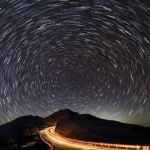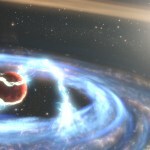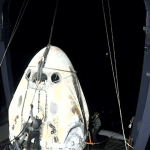Dominique Luchart's Blog, page 635
May 3, 2021
Space junk is blocking our view of the stars, scientists say, ,

The night sky is becoming increasingly filled with shiny satellites and space junk that pose a significant threat to our view of the cosmos, as well as astronomical research, a new study warns.
The researchers found that the more than 9,300 tons (8,440 metric tons) of space objects orbiting Earth, including inoperative satellites and chunks of spent rocket stages, increase the overall brightness of the night sky by more than 10% over large parts of the planet.
Such an increase would mean large swathes of the planet are considered light polluted, making it increasingly difficult for astronomers to take accurate measurements, and increasing the likelihood that they will miss significant discoveries altogether, the researchers said in the journal Monthly Notices of the Royal Astronomical Society.
Related: Here’s every spaceship that’s ever carried an astronaut into orbit
“We expected the sky brightness increase would be marginal, if any, but our first theoretical estimates have proved extremely surprising and thus encouraged us to report our results promptly,” lead study author Miroslav Kocifaj, a senior researcher at the Slovak Academy of Sciences, said in a statement.
The researchers calculated the change in brightness by developing a model that takes into account the average size and brightness of each piece of debris.
According to the researchers, satellites and space garbage ruin astronomical images by scattering reflected sunlight, producing bright streaks that are indistinguishable from — and often brighter than — objects of astrophysical interest, making it difficult if not impossible for them to get a clear picture.
The researchers found that this effect is most pronounced when viewing the cosmos with low-resolution detectors, such as the human eye, resulting in a diffuse brightness across all of the night sky. Telescopes with high angular resolution and high sensitivity may also have part of their images ruined by the light pollution, although they can likely resolve the junk-reflected light into smears. Nevertheless, this could potentially obscure astronomical sights, such as the glowing clouds of stars along the disk of the Milky Way, wherever in the world star-gazers happen to be.
“Unlike ground-based light pollution, this kind of artificial light in the night sky can be seen across a large part of the Earth’s surface,” study co-author John Barentine, director of public policy for the International Dark-Sky Association, said in the statement. “Astronomers build observatories far from city lights to seek dark skies, but this form of light pollution has a much larger geographical reach.”
And the night sky could get even junkier and brighter, especially with the ongoing installation of “mega-constellations,” — large arrays of commercial satellites that aim to provide global internet access. At least 12 operators, including Amazon, SpaceX and OneWeb, have plans to launch new mega-constellation satellites or expand existing networks. SpaceX’s Starlink currently has 1,200 satellites in orbit, but the company intends to increase its fleet to 42,000 in the coming decades — roughly 14 times the number of operational satellites in orbit today.
[image error]
Bright streaks caused by SpaceX’s Starlink constellation. (Image credit: Andreas Moller)The increasingly crowded sky also ups the likelihood of satellites colliding with each other and other objects, creating more shiny debris.
RELATED CONTENT
—Space oddity: 10 bizarre things Earthlings launched into space
—The 10 most dangerous space weapons ever
—10 interesting places in the solar system we’d like to visit
One solution to the problem, proposed by the European Space Agency (ESA) in December 2019, is the 2025 launch of a four-armed robot to grab individual items of space junk. ESA is hoping to use the mission as a test for a much wider-reaching operation by a fleet of robot cleaners. In the meantime, ESA’s director general Johann-Dietrich Worner has called for new rules to make companies and agencies that launch satellites responsible for tidying up their litter.
A team of Australian scientists has even proposed blasting the junk from space with a laser, Live Science previously reported.
The researchers hope that their paper will raise awareness of the detrimental effects of a trash-filled night sky.
“Our results imply that many more people than just astronomers stand to lose access to pristine night skies,” Barentine said. “This paper may really change the nature of that conversation.”
Originally published on Live Science
The post Space junk is blocking our view of the stars, scientists say, , appeared first on NEWDAWN Blog.
The youngest exoplanet found by the Hubble telescope is the size of Jupiter (and still growing), ,

The Hubble Space Telescope has peered out into the cosmos and spotted its youngest exoplanet yet, a giant world 379 light-years from Earth that’s still growing.
Planets form as dust and gas, swirling around in a circumstellar disk surrounding their star, collides and condenses to slowly become a “ball.” Far out in the constellation Centaurus, Hubble has spotted a planet still coming together. The young gas giant exoplanet, designated PDS 70b, is “just” 5 million years old, Hubble scientists said. While the planet is still gathering mass, pulling it from the young star it orbits, it’s already huge — roughly the size of Jupiter.
In a new study, scientists took advantage of this unique opportunity to study a planet in its formative years like PDS 70b with Hubble’s telescope eye. .
“This system is so exciting because we can witness the formation of a planet,” co-author Yifan Zhou, also of the University of Texas at Austin, said in a statement. “This is the youngest bona fide planet Hubble has ever directly imaged.”
Related: 7 ways to discover alien planets
[image error]
The disk around the star in the 70b system that’s feeding the exoplanet PDS 70b. (Image credit: ESO, VLT, Andre B. Muller (ESO))The researchers were able to utilize Hubble’s ultraviolet light sensitivity, which allows them to spot and measure radiation from the hot gas that falls into forming planets, the researchers directly measured the mass growth rate of PDS 70b.
“Hubble’s observations allowed us to estimate how fast the planet is gaining mass,” Zhou said. This is the first time researchers have been able to measure the planet’s mass growth rate.
They also were able to directly image the planet and found that it seems to be coming to the end of its formation process.
Additionally, the team saw a number of “hot spots” glowing in ultraviolet light, which Hubble is attuned to detect. These hot spots, the researchers think, are caused by hot material that extends down to the planet’s surface from magnetic field lines that stretch from the planet’s atmosphere to its star’s circumstellar disk.
[image error]
The exoplanet PDS 70b. (Image credit: MAGE PROCESSING: Joseph DePasquale (STScI) )“If this material follows columns from the disk onto the planet, it would cause local hot spots,” Zhou said. “These hot spots could be at least 10 times hotter than the temperature of the planet.”
While Hubble has spotted over 4,000 exoplanets thus far, on about 15 have been directly imaged, according to the statement. Additionally, most of those 15 exoplanets have looked like dots in photos, as they are so far away and small.
More: This strange lava-rich alien planet is making itself a new atmosphere
“We just don’t know very much about how giant planets grow,” study author Brendan Bowler of the University of Texas at Austin, said in the same statement. “This planetary system gives us the first opportunity to witness material falling onto a planet. Our results open up a new area for this research.”
These observations of PDS 70b aren’t a complete picture of the exoplanet, researchers acknowledged in their statement. Additional data is needed to confirm the mass growth rate and explore the planet further. Studying PDS 70b in more detail can help shed light on how similar gas giant planets form.
While studying PDS 70b,, researchers used a new technique that they think “paves a new route for further exoplanet research, especially during a planet’s formative years,” according to the statement. In this technique, Zhou removed the glare coming from the star in the PDS 70b system.
Stellar glare can be a challenge for scientists studying far-off objects like this exoplanet, and researchers often have trouble studying exoplanets that are close to their host stars. So, by removing the glare the team got a better look at the planet and they paved the way for future researchers to study planets that are closer to their host stars.
“Thirty-one years after launch, we’re still finding new ways to use Hubble,” Bowler added. ” With future observations, we could potentially discover when the majority of the gas and dust falls onto their planets and if it does so at a constant rate.”
Email Chelsea Gohd at cgohd@space.com or follow her on Twitter @chelsea_gohd. Follow us on Twitter @Spacedotcom and on Facebook.
The post The youngest exoplanet found by the Hubble telescope is the size of Jupiter (and still growing), , appeared first on NEWDAWN Blog.
Europe plans to launch space telescope to monitor orbital debris, ,

The European Space Agency (ESA) wants to launch an orbiting telescope to monitor pieces of space debris as small as a few millimeters across. Such tiny fragments of space junk are too small to be spotted with ground-based telescopes, but if they hit a spacecraft, they can cause serious damage.
ESA hopes the satellite, the first of its kind, makes it to space in 2025, provided it gets funding approval at the 2022 council of ESA member states.
The spacecraft, carrying an 8-inche-wide (20 centimeters) optical telescope, would orbit at the altitude of 370 to 430 miles (600 to 700 kilometers), where computer models run by ESA and NASA predict a high density of small space debris fragments, Tim Flohrer, the Head of ESA’s Space Debris Office told Space.com.
“The telescope would be completely passive, working on the principle that the sun illuminates the object and we then detect the reflection from the object,” Flohrer said. “We have to get rather close to the objects. We would not be able to see every object in the millimeter or centimeter range, but we would see enough to validate our models.”
NASA and ESA both run their own space debris models using different approaches, Flohrer said. The models agree on the distribution of larger debris pieces in the orbital environment, which can be validated by ground-based telescopes. But when it comes to smaller fragments, the models’ predictions diverge.
“In the centrimeter regime, we have no real validation means available, and that’s where we see quite significant disagreement between the models,” Flohrer said. “That needs to be tackled because a 1-centimeter [0.4 inches] object can still cause severe damage to an operating satellite. An object of several centimeters could even destroy the satellite.”
ESA has firsthand experience with the wrecking power of tiny space debris. In August 2016, a particle only about a millimeter in diameter punched through a solar panel of the Copernicus Sentinel-1A Earth-observing satellite operated by the agency. Spacecraft operators identified what caused the sudden drop in power generation thanks to onboard cameras designed to monitor the unfolding of the solar panels after launch.
Copernicus Sentinel-1A was able to continue its mission. But the consequences would have been much more severe had the space bullet, which was traveling at 17,000 mph (28,000 kph), hit the main body of the spacecraft, ESA officials said.
ESA estimates that approximately 34,000 space debris pieces larger than 4 inches (10 cm) currently orbit Earth. The number of fragments between 0.4 and 4 inches (1 to 10 cm) is believed to be around 900,000. In addition to that, there could be a staggering 128 million objects between 0.04 and 0.4 inches (1 millimeter to 1 cm)r in size.
Related: Artificial intelligence is learning how to dodge space junk in orbit
“The smaller the objects, the more numerous they are,” Holger Krag, the head of Space Safety at ESA, said at a press briefing during the 8th European Space Debris Conference last week. “Only a very small fraction can actually be seen, but all of them are dangerous because of their high velocities. Unfortunately, what you cannot see, you cannot avoid.”
He added that even a relatively small orbiting telescope would make a big difference in the understanding of the distribution of these dangerous fragments.
“Such a telescope would be able to detect objects of even a few millimeters in size, which are otherwise unobservable from the ground,” Krag said.
Flohrer added that ESA will soon release an invitation to tender for companies to develop components for the telescope. But the mission still needs to obtain some of the required funding at the 2022 council of ESA member states, he said.
Follow Tereza Pultarova on Twitter @TerezaPultarova. Follow us on Twitter @Spacedotcom and on Facebook.
The post Europe plans to launch space telescope to monitor orbital debris, , appeared first on NEWDAWN Blog.
May 2, 2021
New trailers: Castlevania, West Side Story, Sweet Tooth, Luca, and more, Kim Lyons

 Castlevania | Netflix
Castlevania | NetflixJust started watching season four of The Handmaid’s Tale and I remember why I prefer the weekly release schedule for this show: Bingeing it is utterly draining (Monica Hesse makes this point much more eloquently in her mostly spoiler-free review in the Washington Post). The show has a conundrum: it can’t kill off its main character (which would be an incredible plot twist) and it can’t take her out of Gilead because that’s where the action is. So June has to keep suffering over and over. And over. After the first three episodes, June’s done plenty of suffering already. Over the rest of the season I’m really hoping to see A) much more of Alexis Bledel and Samira Wiley and B) something good happen to June. Anything.
Here’s the roundup of…
The post New trailers: Castlevania, West Side Story, Sweet Tooth, Luca, and more, Kim Lyons appeared first on NEWDAWN Blog.
New trailers: Castlevania, West Side Story, Sweet Tooth, Luca, and more,

Just started watching season four of The Handmaid’s Tale and I remember why I prefer the weekly release schedule for this show: Bingeing it is utterly draining (Monica Hesse makes this point much more eloquently in her mostly spoiler-free review in the Washington Post). The show has a conundrum: it can’t kill off its main character (which would be an incredible plot twist) and it can’t take her out of Gilead because that’s where the action is. So June has to keep suffering over and over. And over. After the first three episodes, June’s done plenty of suffering already. Over the rest of the season I’m really hoping to see A) much more of Alexis Bledel and Samira Wiley and B) something good happen to June. Anything.
Here’s the roundup of this week’s trailers:
[embedded content]West Side StorySteven Spielberg’s remake of the classic musical looks a lot like the original 1961 film at first glance (this side-by-side comparison from YouTuber Matt Skuta shows the many differences). But while the earlier film included white actors in makeup to play some of the Puerto Rican characters, Spielberg sought performers of Puerto Rican descent for his updated version. The spectacular Rita Moreno, who starred in the original as Anita appears in the Spielberg version, and is also an executive producer on the film. West Side Story hits theaters (after a lengthy COVID-related delay) in December.
[embedded content]CastlevaniaThe latest 10-episode season of Castlevania is going back to “where it all started,” according to the new trailer. The official synopsis from Netflix says “Wallachia collapses into chaos as factions clash” and mentions attempts to bring Dracula back from the dead (!!). “These are the end times.” This is the final season with this cast of characters (Deadline has reported Netflix may launch a new series in the Castlevania-verse but with different characters), so expect plenty of blood. Season four of Castlevania drops on Netflix May 13th.
[embedded content]LucaOK so as a parent, I am always a bit wary of Disney/Pixar movies, because they are typically emotionally devastating for parents to watch (see: Finding Nemo, or perhaps Inside Out, or maybe the final scene of Toy Story 3) (aaand I just cried all over again dammit). Luca is the story of two young sea monsters who become human when they’re not in the water as they explore the surface world in a seaside town on the Italian Riviera. Seems safe enough and the trailer looks beautiful but Pixar always gets you, so don’t say I didn’t warn you. Luca hits Disney Plus on June 18th.
[embedded content]Sweet ToothSweet Tooth is a post-apocalyptic fairytale based on a DC Comic, with Robert Downey, Jr. as executive producer (is that the most Verge-y sentence I have ever written? Possibly.). Our hero is a very cute hybrid deer-boy played by Christian Convery, who’s searching for a new beginning after society has been upended by something called The Great Crumble. Sweet Tooth arrives on Netflix June 4th.
[embedded content]Rick and Morty Season 5The second trailer for season 5 of Rick and Morty picks up where the first trailer left off, which is to say, in the middle of a chaotic space battle? with cyberpunk birds? that is a parody of the Power Rangers? Sure, why not. Rick and Morty returns to Adult Swim on June 20th.
The post New trailers: Castlevania, West Side Story, Sweet Tooth, Luca, and more, appeared first on NEWDAWN Blog.
iFixit drilled a key ring hole into one of Apple’s AirTags in its latest teardown, Kim Lyons

 iFixit did a teardown of Apple’s AirTags | iFixit
iFixit did a teardown of Apple’s AirTags | iFixitThe team over at iFixit has done its teardown thing again, this time examining Apple’s AirTag trackers. Part one of its two-part review digs into the guts of the little trackers, and for those lamenting the lack of a key ring loop on the AirTag, iFixit (carefully) drilled a hole into one without damaging any of its parts.
After some reconnaissance inside our first AirTag, we grabbed a 1/16” drill bit and carefully punched a hole through the second tracker in our four-pack—after removing the battery, of course. We miraculously managed to avoid all chips, boards, and antennas, only drilling through plastic and glue. The best part? The AirTag survived the operation like a champ and works as if nothing happened.
The team cautioned that you…
The post iFixit drilled a key ring hole into one of Apple’s AirTags in its latest teardown, Kim Lyons appeared first on NEWDAWN Blog.
iFixit drilled a key ring hole into one of Apple’s AirTags in its latest teardown,

The team over at iFixit has done its teardown thing again, this time examining Apple’s AirTag trackers. Part one of its two-part review digs into the guts of the little trackers, and for those lamenting the lack of a key ring loop on the AirTag, iFixit (carefully) drilled a hole into one without damaging any of its parts.
After some reconnaissance inside our first AirTag, we grabbed a 1/16″ drill bit and carefully punched a hole through the second tracker in our four-pack–after removing the battery, of course. We miraculously managed to avoid all chips, boards, and antennas, only drilling through plastic and glue. The best part? The AirTag survived the operation like a champ and works as if nothing happened.
The team cautioned that you have to remove the battery before drilling, and warned that drilling in the wrong place can cause serious damage. So try this at home only if you have skill with a drill.
 iFixit drilled a hole into an AirTag for a keyring, and it survivediFixit
iFixit drilled a hole into an AirTag for a keyring, and it survivediFixitiFixit compared ?its AirTags? to the Tile Mate and the Samsung Galaxy SmartTag. AirTags are the smallest of the bunch, with its 3-volt coin cell removable battery– type CR2032, same as the one SmartTags use–taking up most of the internal space. “All three trackers open up with finger power–no other tools required,” according to iFixit, but they found the AirTag’s was the most difficult to remove.
 From left: Tile Mate, Galaxy SmartTag, and Apple AirTagiFixit
From left: Tile Mate, Galaxy SmartTag, and Apple AirTagiFixitAn X-ray of the three tags shows Apple made efficient use of its internal space, nothing that “the relative darkness of the AirTag [in the X-ray image] is due to a hefty central speaker magnet and its steel battery cover. iFixit tweeted a 360-video of the X-ray image:
What are we tearing down on iFixit tomorrow? All we know is it looks like it fell off of Tony Stark’s latest suit. Good thing we had help from @CreativeElctrn Stay tuned pic.twitter.com/IuYqlDPpr4
— iFixit (@iFixit)
Check out the full iFixit tear down of Apple’s AirTags here. And coming soon, they’ll have detailed board shots and a look at the onboard silicon, presumably in part two.
The post iFixit drilled a key ring hole into one of Apple’s AirTags in its latest teardown, appeared first on NEWDAWN Blog.
Facebook and Instagram notices in iOS apps tell users tracking helps keep them ‘free of charge’,

Facebook is continuing its campaign against Apple’s iOS 14 privacy updates, adding a notice within its iOS app telling users the information it collects from other apps and websites can “help keep Facebook free of charge.” A similar message was seen on Instagram’s iOS app (Facebook is Instagram’s parent company).
Technology researcher Ashkan Soltani first noted the new pop-up notices on Saturday (see his tweet below), but a Facebook spokesperson directed The Verge to a blog post from earlier last week that detailed the update. The company refers to the notices as “educational screens,” and said they provided “more details about how we use data for personalized ads,” according to the blog post by Dan Levy, Facebook’s vice president for ads and business products.
“This version of iOS requires us to ask for permission to track some data from this devices to improve your ads. Learn how we limit the use of this information if you don’t turn on this device setting,” the screen reads. “We use information about your activity received form other apps and websites to: show you ads that are more personalized, help keep Facebook free of charge [and] support businesses that rely on ads to reach their customers.”
And it begins. @Facebook / @Instagram explore additional scare tactics to combat @Apple iOS14 #ATT privacy changes.
“Help keep Facebook free of charge” pic.twitter.com/mOB9WJpz9A
— ashkan soltani (@ashk4n)
The new opt-in requirements in the latest versions of iOS 14, including iOS 14.5, require developers to get express consent from device owners to allow their Identifier for Advertisers (IDFA) to be shared and collected across apps. Under Apple’s new policy, app developers are still able to use other information a user provides for targeted advertising, even if the user opts out of letting the app track them, but that information can’t be shared with another company for ad tracking.
If developers try to get around the opt-in requirement, or try to replace the IDFA with another piece of identifying information such as an email address, that app will be considered in violation of the opt-in requirement. The rules also apply to Apple’s own apps.
Facebook has been a vocal critic of Apple’s iOS 14 privacy updates, arguing that the privacy changes could hurt small businesses which may rely on Facebook’s ad network to reach customers. In statements to the press and in newspaper ads, Facebook has said Apple is encouraging new business models for apps so they rely less on advertising and more on subscriptions, which would potentially give Apple a cut.
But the “keep Facebook/Instagram free” tactic seems to run counter to Facebook’s long-standing tagline which indicated the company was “free and always will be.” Of course, Facebook quietly removed that slogan from its homepage in 2019, and CEO Mark Zuckerberg didn’t rule out a paid version of Facebook when he testified before Congress in 2018. “There will always be a version of Facebook that is free,” he said.
Zuckerberg called Apple out during Facebook’s January earnings call, referring to Apple as one of his company’s biggest competitors. “Apple has every incentive to use their dominant platform position to interfere with how our apps and other apps work, which they regularly do to preference their own,” Zuckerberg said. “This impacts the growth of millions of businesses around the world, including with the upcoming iOS 14 changes.”
Apple didn’t reply to a request for comment Sunday.
Update: May 2nd, 1:40PM ET: Adds information from Facebook including updated image of the screens
The post Facebook and Instagram notices in iOS apps tell users tracking helps keep them ‘free of charge’, appeared first on NEWDAWN Blog.
Microsoft wants to reduce its Xbox store cut and shake up console gaming, Tom Warren

 Illustration by Alex Castro / The Verge
Illustration by Alex Castro / The VergeMicrosoft has been planning to cut its Xbox store cut to just 12 percent, according to confidential documents filed in the Epic Games vs. Apple case. The software maker details its store fees and changes in a document from January, where it also lists the 12 percent cut to PC games it announced this week. While most of the important parts of the document are redacted, one page reveals Microsoft also wants to reduce its 30 percent store cut on the Xbox console side.
A table reveals “all games will move to 88 / 12 in CY21,” which means Microsoft had been planning a significant cut to Xbox transactions for some point in the 2021 calendar year. While Microsoft has announced its PC cut, which is also listed in the same table, the company has…
The post Microsoft wants to reduce its Xbox store cut and shake up console gaming, Tom Warren appeared first on NEWDAWN Blog.
Watch live: SpaceX Crew-1 post-splashdown news conference, ,

SpaceX’s first operational astronaut mission for NASA, Crew-1, returned to Earth early Sunday (May 2). A post-splashdown news conference with NASA and SpaceX officials will follow at 5 a.m. EDT (0900 GMT), and you can watch it live here, courtesy of NASA TV.
After six months in space, the Crew-1 Dragon spacecraft Resilience undocked from the International Space Station on Saturday (May 1) at 8:35 p.m. EDT (0035 GMT) and splashed down in the Gulf of Mexico, off the coast of Panama City, Florida, on Sunday at 2:56 a.m. EDT (0656 GMT). NASA will provide continuous coverage of the Crew Dragon spacecraft’s return to Earth on NASA TV.
Crew-1’s return to Earth wrapped up the Expedition 64 mission to the space station. Returning home on Resilience were NASA astronauts Victor Glover, pilot; Mike Hopkins, commander; Shannon Walker, mission specialist and Japan Aerospace Exploration Agency astronaut Soichi Noguchi, mission specialist. The astronauts launched to the station on a SpaceX Falcon 9 rocket in November.
Live updates: SpaceX’s Crew-1 astronaut mission to the space station
[image error]
SpaceX’s Crew Dragon “Resilience” is pictured on the GO Navigator recovery vessel after splashing down in the Gulf of Mexico, on May 2, 2021. (Image credit: SpaceX)Editor’s Note: This advisory was updated April 30, 2021, with new information and target dates for the return of the agency’s SpaceX Crew-1 mission.
Editor’s Note: This advisory updates the original advisory issued April 24, 2021 .
NASA’s SpaceX Crew-1 mission with NASA astronauts Michael Hopkins, Victor Glover, and Shannon Walker, and Soichi Noguchi of the Japan Aerospace Exploration Agency (JAXA) is now targeting a return to Earth no earlier than about 2:57 a.m. EDT Sunday, May 2, in the Gulf of Mexico off the coast of Florida. The Crew Dragon spacecraft, named Resilience, is scheduled to undock from the International Space Station at 8:35 p.m. Saturday, May 1, to begin the journey home.
NASA and SpaceX decided to move Crew-1’s undocking and splashdown from Friday, April 30, and Saturday, May 1, respectively, following a review of the forecast weather conditions in the splashdown zones off the coast of Florida, which predicted wind speeds above the return criteria. Crew Dragon is in great health on the space station, and teams now forecast ideal conditions for both splashdown and recovery during the weekend.
The return to Earth – and activities leading up to the return – will air live on NASA Television, the NASA App, and the agency’s website.
This will be the first night splashdown of a U.S. crewed spacecraft since Apollo 8’s predawn return in the Pacific Ocean on Dec. 27, 1968, with NASA astronauts Frank Borman, Jim Lovell and Bill Anders.
Crew-1 is the first of six crewed missions NASA and SpaceX will fly as part of the agency’s Commercial Crew Program, which worked with the U.S. aerospace industry to return launches with astronauts on American rockets and spacecraft from American soil.
The Crew Dragon will undock autonomously and depart from the space station with the capability to splashdown at one of seven targeted landing zones in the Atlantic Ocean or Gulf of Mexico off the coast of Florida. Resilience also will return to Earth important and time-sensitive research. The NASA and SpaceX teams select a primary and alternate splashdown location from the seven possible landing locations about two days prior to return, factoring in weather, crew rescue, and recovery operations. Additional decision milestones take place prior to undocking, during free flight, and before Crew Dragon performs the deorbit burn.
NASA and SpaceX closely coordinate with the U.S. Coast Guard to establish a 10-nautical-mile safety zone around the expected splashdown location to ensure safety for the public and for those involved in the recovery operations, as well as the crew aboard the returning spacecraft.
NASA’s SpaceX Crew-1 return coverage is as follows (all times are Eastern):
Saturday, May 1
6 p.m. – NASA TV coverage begins for 6:20 p.m. hatch closure
8:15 p.m. – NASA TV coverage begins for 8:35 p.m. undocking
Sunday, May 2
2:57 a.m. (approx.) – Splashdown (NASA TV will provide continuous coverage from undocking to splashdown)
5 a.m. – Return to Earth news conference at NASA’s Johnson Space Center in Houston, with the following participants:
Media wishing to participate in the Return to Earth news conference by telephone must call Johnson’s newsroom at 281-483-5111 to RSVP no later than 4 a.m. Sunday, May 2. Those following the briefing on social media may ask questions using #AskNASA.
NASA’s Commercial Crew Program has delivered on its goal of safe, reliable, and cost-effective transportation to and from the International Space Station from the United States through a partnership with American private industry. This partnership is changing the arc of human spaceflight history by opening access to low-Earth orbit and the International Space Station to more people, more science, and more commercial opportunities. The space station remains the springboard to NASA’s next great leap in space exploration, including future missions to the Moon and, eventually, to Mars.
Learn more about space station activities by following @space_station, and @ISS_Research on Twitter, as well as the ISS Facebook and ISS Instagram accounts and the space station blog.
Learn more about splashdown locations, weather criteria, and recovery logistics, at:
https://www.nasa.gov/feature/nasa-s-spacex-crew-rescue-and-recovery/
See full mission coverage, NASA’s commercial crew blog, and more information about the mission at:
https://www.nasa.gov/commercialcrew
-end-
Find out what the astronauts and cosmonauts aboard the International Space Station are up to by tuning in to the “ISS Live” broadcast. Hear conversations between the crew and mission controllers on Earth and watch them work inside the U.S. segment of the orbiting laboratory. When the crew is off duty, you can enjoy live views of Earth from Space. You can watch and listen in the window below, courtesy of NASA.
“Live video from the International Space Station includes internal views when the crew is on-duty and Earth views at other times. The video is accompanied by audio of conversations between the crew and Mission Control. This video is only available when the space station is in contact with the ground. During ‘loss of signal’ periods, viewers will see a blue screen.
“Since the station orbits the Earth once every 90 minutes, it experiences a sunrise or a sunset about every 45 minutes. When the station is in darkness, external camera video may appear black, but can sometimes provide spectacular views of lightning or city lights below.”
Follow us on Twitter @Spacedotcom and on Facebook.
The post Watch live: SpaceX Crew-1 post-splashdown news conference, , appeared first on NEWDAWN Blog.



